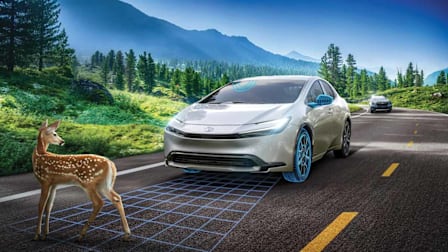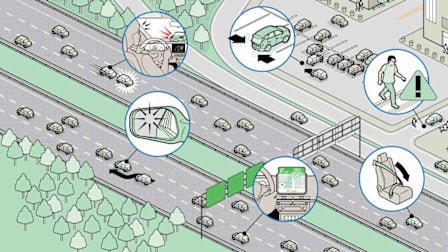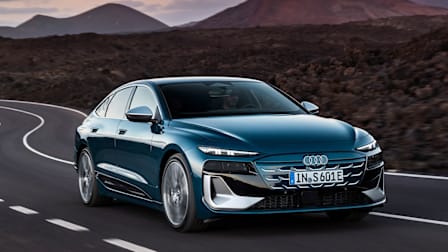Ford BlueCruise Rivals GM’s Super Cruise for Balancing Automation and Driver Monitoring
This new active driver assistance system stands out for allowing the driver to intervene without shutting off
We just evaluated the new Ford BlueCruise active driver assistance system on a 2021 Mustang Mach-E electric vehicle and came away with mostly positive feelings. The system can allow for hands-free driving on sections of premapped divided highways, automating the vehicle’s steering, acceleration, and braking for the driver. It stands out for its driver monitoring and appropriate warnings when driver attention appears to have wandered, plus it effectively encourages collaborative driving.
BlueCruise is similar to General Motors’ Super Cruise—currently the top-rated active driver assistance system in Consumer Reports’ tests—in that it uses a direct driver monitoring system, via an infrared camera mounted on top of the steering column, to make sure the driver is looking at the road.
CR feels it is imperative that active driver assistance systems—which combine lane centering assist (LCA) and adaptive cruise control (ACC)—use direct driver monitoring to make sure the driver is looking at the road to help keep their car and other vehicles around it safe. Most current active driver assistance systems, including Tesla’s Autopilot, do not use effective direct driver monitoring, and instead require occasional hand pressure on the steering wheel as a means to make sure the driver is paying attention.
@consumerreports Tesla’s system fails to keep a driver's attention on the road. Ford's issues an alert when the driver's eyes are diverted. #cartok #tesla #ford ♬ original sound - Consumer Reports
CR's Take
BlueCruise worked well during our preliminary evaluations on a Mustang Mach-E rented from Ford. The system is easy to activate because it takes only a single press of the cruise control button on the steering wheel to simultaneously engage the ACC and LCA. After that, all the driver has to do is stay attentive, ready to take over the steering on certain curvy sections of highways and manage the little stuff, such as steering to avoid potholes and manually adjusting the ACC’s speed, if they wish.
We found BlueCruise enjoyable to use because it provides steering assistance on straight, boring sections of highway, or when you’re stuck in a traffic jam, which can make driving less stressful and more relaxing.
We’re happy with Ford’s decision to utilize a driver monitoring camera to ensure that the driver is paying attention to their surroundings any time the system is active, whether on highways or secondary roads.
We will fully test BlueCruise when the system becomes available through an over-the-air update on our 2021 Mustang Mach-E test car.
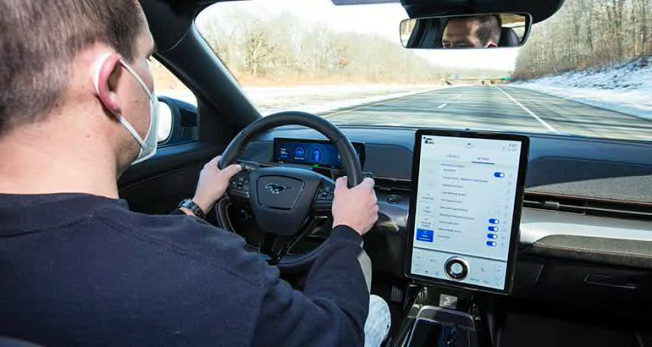
Photo: Consumer Reports Photo: Consumer Reports
BlueCruise Strengths
- Direct driver monitoring to make sure the driver is paying attention to the road.
- Allows for the driver to make their own steering-wheel inputs without immediately shutting the system off.
- Simple to activate by pressing a single button on the steering wheel.
- The system works on nonhighway roads with lane lines, but it still requires the driver to have their hands on the wheel and eyes on the road.
BlueCruise Weaknesses
- BlueCruise doesn’t make it clear to the driver why it’s telling you to suddenly put your hands back on the wheel, or why the system won’t engage “hands-free” mode at times on divided highways.
- Hands-free mode doesn’t always engage immediately after pressing the cruise-control button, with no explanation as to why.
- Ford’s marketing of BlueCruise as “a hands-off highway driving experience” overstates the true experience.
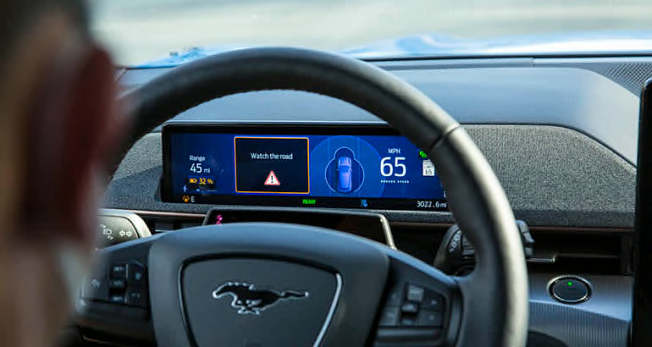
Photo: John Powers/Consumer Reports Photo: John Powers/Consumer Reports
The Camera Is the Key
BlueCruise hands-free driving is available only on “prequalified” (Ford’s term for GPS mapped or premapped) sections of divided highways called “Hands-Free Blue Zones.” Those zones cover about 130,000 miles of North American roads, according to the automaker. Thanks to Ford’s mapping data, BlueCruise knows information such as the GPS location of the lane, lane width, lane curvature, and changes in elevation. The information is onboard the vehicle, and Ford will update the maps over the air as needed.
But a key reason BlueCruise works so well is that the driver has to pay attention to the road. The system uses a driver-facing infrared camera perched atop the steering column that monitors the driver’s eyes and head gaze. If the driver glances away from the road for too long (about 5 seconds in our experience)—whether to look at their cell phone, fiddle with the infotainment screen, or because they fell asleep—the system will give the driver a visual warning to “Watch the road” within the instrument cluster, followed by an audible warning chime. The driver monitoring works effectively at detecting when the driver is looking away from the road, and it was not thrown off by sunglasses or a face mask. We didn’t find that it warned us so quickly that it became annoying.
Among BlueCruise’s advantages over competing systems is its simple activation process: All the driver has to do is press the cruise control button on the steering wheel (provided the system is set to adaptive cruise control, as opposed to “normal cruise control,” within the driver assistance settings on the infotainment screen) and the system is activated.
But although pressing the cruise control buttons turns the system “on,” the hands-free aspect won’t necessarily engage immediately—sometimes it does; other times it can take a few seconds to a couple of minutes. The system has to be on a section of divided highway that it deems safe for hands-free driving. The driver will know the hands-free mode has been engaged when the instrument cluster background turns from white to blue, while showing a steering wheel with the words “hands-free” below it.
We asked Ford representatives what parameters cause the system to suddenly switch out of hands-free mode, and were told it could be a number of things, from overly curvy lanes to unclear lane lines.
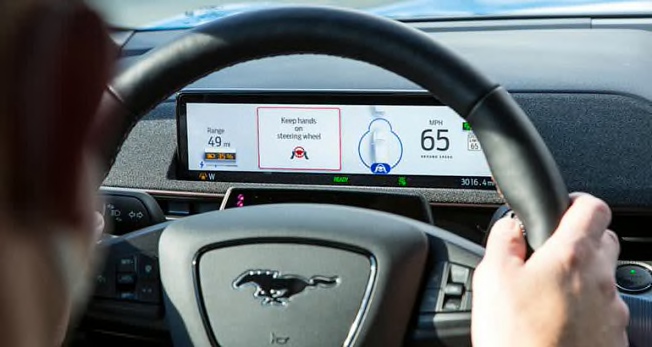
Photo: John Powers/Consumer Reports Photo: John Powers/Consumer Reports
Works With the Driver, Not Against
As with Autopilot and Super Cruise, the BlueCruise system steers the vehicle to keep it near the center of the lane, yet unlike those other systems it doesn’t fight the driver if they want to take corrective action to dodge a pothole, or steer around a pedestrian or cyclist. Once the steering correction is made, the system seamlessly resumes control. With some competing systems, adding your own steering inputs deactivates the steering assistance, which means the driver will then have to reactivate it.
Not only is it annoying to have to reactivate the system, but having to do so can also be a deterrent to the driver adding their own steering inputs, or using the system at all. With BlueCruise, even if the driver takes over the steering, the system still provides lane centering steering-wheel torque, but we found that it works with the driver instead of feeling like it’s working against them.
We see this as a big win, because systems shouldn’t “penalize” the driver for adding their own steering inputs.
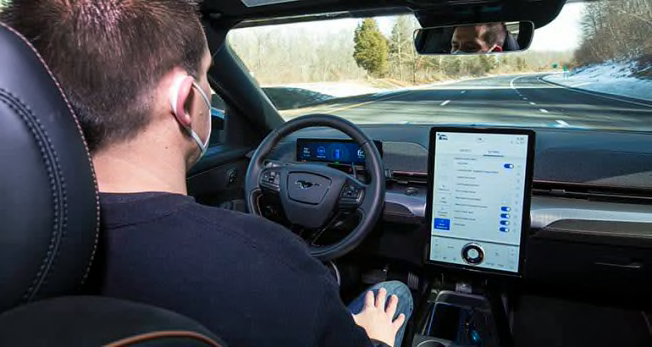
Photo: John Powers/Consumer Reports Photo: John Powers/Consumer Reports
BlueCruise Correctly Suggests Its Limitations
Unlike the inappropriately named Autopilot and other active driver assistance systems, the BlueCruise system is “more honest” about its limitations, says Kelly Funkhouser, CR’s manager of vehicle technology. “In our experience so far, BlueCruise seems to perform well in areas such as lane centering, ease of use, and driver monitoring,” she says. “But one of the aspects we really like about BlueCruise is that it doesn’t say to the driver, ‘I’ve got this, don’t worry about steering,’ which can lead to a false sense of complacency.”
Instead, BlueCruise asks the driver to “Keep hands on steering wheel” on curvy stretches of highway. “It’s not necessarily ending its steering assistance,” Funkhouser says, “but the system wants the driver to have their hands on the wheel for safety just in case the automation can’t actually handle the turn.”
“I love driving,” Fisher says. “But not on boring, straight stretches of highway or in stop-and-go traffic.” In those situations, BlueCruise can automate the steering, braking, and accelerating for you pretty well.
“I still want to be in charge during higher-risk driving, such as through fast or tight curves,” Fisher continues. “BlueCruise has the ability to sense those sections ahead of time, and it makes sure you have your hands on the wheel so you’re at the ready.”
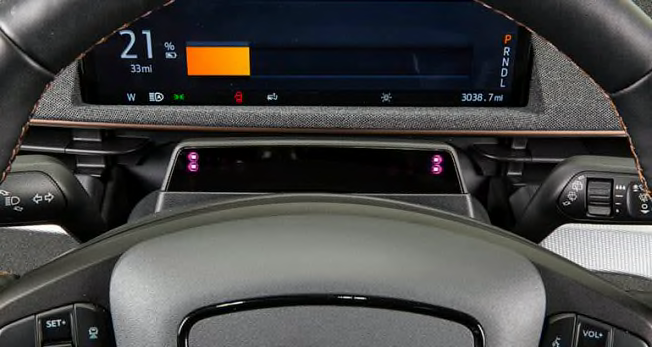
Photo: John Powers/Consumer Reports Photo: John Powers/Consumer Reports
Mixed Messaging
Ford’s marketing of BlueCruise as a “hands-off highway driving experience” is potentially misleading to consumers. People may be confused or feel misled when they find out that BlueCruise wants them to have their hands on the steering wheel quite often on curvier sections of highway. Many customers may assume “hands-free” actually means “hands-free at all times,” and in our experience so far, that simply isn’t the case with BlueCruise, even on premapped sections of divided highway.
BlueCruise is currently available on the F-150 full-sized pickup and Mustang Mach-E EV. The system will be coming to the 2022 Expedition Platinum soon, as well as the upcoming F-150 Lightning EV pickup. A Ford spokesman told us BlueCruise would be heading to more vehicles, as well, but declined to give specifics as to which models, and the time frame.

















